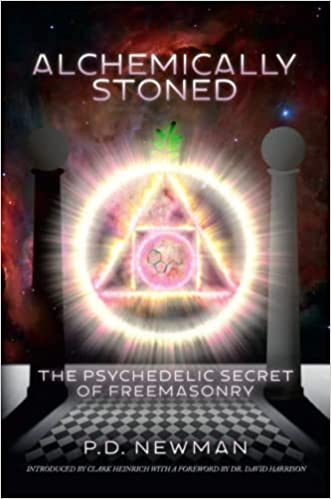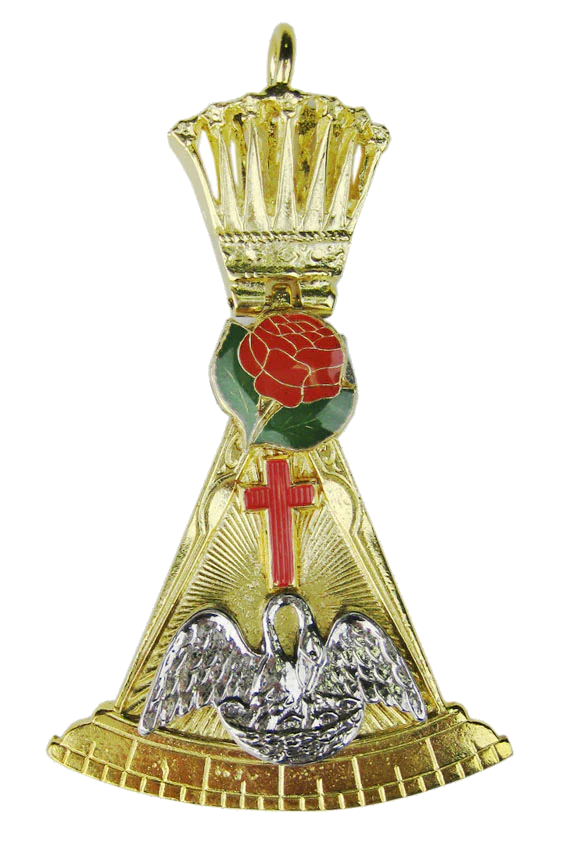ANCIENT & ACCEPTED Scottish rite: 18th° DEGREE – knight rose Croix
In Summary:
The 18th degree “Knight Rose Croix” is one of the degrees in the Chapter of Rose Croix, which is presided over by the Wise Master. The degree is symbolized by the Rose Croix jewel, which features a pelican feeding its young with a sprig of acacia, a rose, and a cross on the front side of the medallion. The degree was revised by Albert Pike between 1859 – 1891, and he removed any obligation for the degree candidate to complete a Christian duty but kept in place the fundamental character of ritual.
Initial Note:
This degree teaches that life and its strengths come from God. The rose signifies the dawn and the cross is a sacred symbol of antiquity in many cultures. To be tolerant of others’ errors and faults.
Regalia Notes:
The apron is white satin bordered with crimson on one side and black on the other. On the white side is embroidered the pelican side of the jewel. On the black side is a large red passion cross.
The cordon, worn from left to right, is of velvet or silk, crimson on one side and black on the other; it is plain on the crimson side. A red passion cross is embroidered on the black side and worn over the heart.
The colors of the cordon and apron, white and crimson, are symbols of light and the dawn of day and represent Faith, Hope, and Charity.
The jewel is the compass with points opened to sixty degrees and resting on the segment of a graduated circle. On the lower part, on one side, is an eagle, with his wings extended and head lowered. Among the Egyptians, the eagle was the emblem of a wise man because his wings bore him above the clouds into the purer atmosphere and nearer to the
source of light, and his eyes were not dazzled with that light. Since the eagle also represented the great Egyptian Sun god Amun-Ra, it is a symbol of the infinite Supreme Reason or Intelligence. On the other side is a pelican, piercing its breast to feed its seven young in a nest under it.
The pelican symbolizes every philanthropist and reformer who has offered up his life for the benefit of humanity, and so teaches us an exhaustless munificence toward all men, especially the needy and defenseless. It also represents the large and bountiful beneficence of nature, from whose bosom all created things draw their sustenance. Thus, the pelican and eagle together are symbols of perfect wisdom and perfect devoutness.
There is a crimson cross showing on both sides; at the intersection of its arms on the pelican side, is a crimson rose in bloom. The cross, pointing to the four cardinal directions, and whose arms, infinitely extended would never meet, is an emblem of space or infinity. The cross has been a sacred symbol in many cultures from the earliest antiquity.
The rose was anciently sacred to the sun and to Aurora, the Greek Goddess of the dawn. As a symbol of the morning light, it represents resurrection and the renewal of life, and therefore immortality. Together the cross and rose symbolize immortality won by suffering and sorrow. On the summit of the compasses is an antique crown. On the segment of the circle, on the pelican side, is the word of this degree in a special cipher. This jewel is of gold; the pelican and eagle upon it of silver.
Duties are:
• Practice virtue that it may produce fruit. Labor to eliminate vice, and purify humanity. Be tolerant of the faith and creed of others.
For Reflection:
• Do evil and calamity exist to provide an opportunity for the practice of virtue? Do your attitudes and actions reflect faith, hope, and charity?
Lessons:
• We should have faith in God, mankind, and ourselves. We should hope for victory over evil, the advancement of humanity, and a hereafter. Charity is relieving the wants and tolerating the errors and faults of others.
Important Symbols:
• The constellations called Faith, Hope, and Charity, the punishments and terrors of Hell, the rose, the cross, the pelican, and the eagle.
Additional Notes:
This degree sets forth the coming of the New Law, the Law of Love, proclaimed in unmistakable terms by Jesus of Nazareth after centuries of spiritual and intellectual darkness in the world when the Sacred Word was again lost. The supreme message brought to the world at that time was the proclamation of the Fatherhood of God and the Brotherhood of man. This proclamation, though presented by a specific historical figure, is not to be taken as an advocation of a particular religious belief.
Tolerance is also taught as we are led through a myriad of examples from the many and diverse beliefs of the ancients which teach us that neither the cross as a symbol nor the notion of a messiah are uniquely Christian. They are manifestations of religious truths appropriate to the people who perceived them. From these examples, we may conclude that tolerance is not simply a duty, but an inescapable conclusion. The instructions on the concept of a messiah are suggestive only and are not to be taken as official doctrine or dogma of Freemasonry in general, or the Scottish Rite in particular; the religious test of Masonry is far too universal to admit of such a demand. As Pike says in the lecture on this degree, “No Mason has the right to interpret the symbols of this Degree for another, or to refuse him its mysteries…”.
Sources:
Purchase ‘A Bridge To Light‘ by Rex R. Hutchens
Purchase ‘Morals & Dogma‘ by Albert Pike.
Additional Sources:
https://scottishrite.org/blog/virtualtour/scottish-rite-18th-degree-knight-rose-croix-jewel/
https://scottishritenmj.org/blog/history-18th-degree

‘Knight Rose Croix’
Please view the video on the left, for a more detailed explanation of the 18th° Degree.

Left: A hypothesis on the use of the Acacia within ancient Freemasonry, a book written by Bro. P.D. Newman
Right: An interview with Bro. P.D. Newman regarding the hypothesis of the use of Acacia in Ancient Freemasonry as well as other interesting information.



